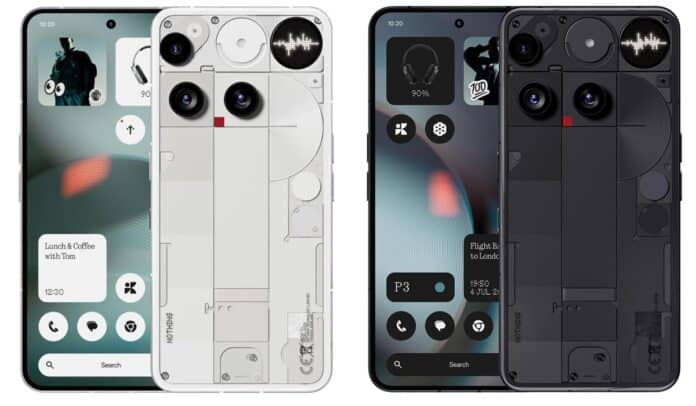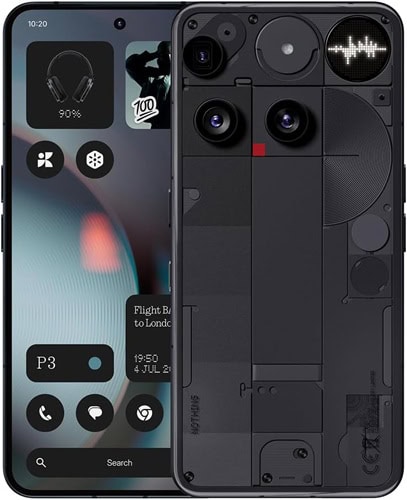Nothing has officially announced its first ‘flagship’ phone, the Nothing Phone 3, nearly two years after the launch of its predecessor, the Phone (2). The Phone (3) still features the classic modular ‘Nothing’ look, complete with a 6.67-inch AMOLED display, three 50-megapixel rear cameras, a Glyph Matrix display, and a large 5150 mAh silicon-carbon battery. Powering the Nothing Phone 3 is the Snapdragon 8s Gen 4 chipset, paired with a 5,150mAh battery, and it ships with Nothing OS 3.5 based on Android 15, promising up to five years of OS updates and seven years of security patches.
Nothing Phone 3 Key Specs and Features
- 6.67 inches OLED Display, 1260 x 2800 pixels (~460 ppi density), 120Hz Refresh Rate, up to 4500 nits Brightness
- 489-LED Monochrome Rear Display for Notifications and Flashlight
- Android 15, up to 5 major Android upgrades, Nothing OS 3.5
- Qualcomm SM8735 Snapdragon 8s Gen 4 (4 nm) Octa Core Processor
- 12GB, 16GB RAM
- 50 MP (wide) + 50 MP (periscope telephoto) + 50 MP (ultrawide) Triple Rear Camera
- 50 MP Front Camera
- Fingerprint Sensor (under display, optical)
- 256GB, 512GB Built-in Storage
- Dust and Water Resistance (IP68)
- 4G LTE Support
- 5G Support
- Wi-Fi 6 and Wi-Fi 7 Support
- eSIM Support
- 65W Fast Charging Capacity
- 15W Wireless Charging Capacity
- 5150 mAh Si/C Battery
Design
The Nothing Phone 3 confidently carries forward the brand’s signature design ethos, but with a more mature and refined interpretation. From the moment you pick it up, the phone feels unapologetically different, bold, futuristic, and undeniably premium.
Weighing in at 218g and measuring 9mm thick, it’s heavier and chunkier than most mid-range phones, but this weight lends it a substantial, solid feel that screams flagship craftsmanship.
The phone feels solid in hand, thanks to its aerospace-grade aluminum frame combined with Gorilla Glass Victus on the back and Gorilla Glass 7i on the front. Despite packing a large 5,150mAh silicon-carbon battery, the Phone (3) manages a surprisingly balanced weight distribution, offering a reassuring heft without being unwieldy. It’s both thinner and more comfortable to hold than the Phone (2), with curved edges that blend more naturally into the hand.
Up front, the panel is dominated by a large 6.67-inch display. The bezels are razor-thin, just 1.9mm all around, providing an immersive display experience that rivals far more expensive devices
What makes the Nothing Phone 3 instantly recognizable is its transparent rear panel, a design choice that’s become synonymous with the brand. Unlike the more playful layouts of the Phone (1) and Phone (2), the Phone (3) opts for a cleaner, more architectural look, especially in the camera arrangement area.
The rear camera and Glyph layout boldly embrace asymmetry: three 50 MP lenses and a circular Glyph Matrix cluster at the top corner. It’s polarizing, described alternately as “utterly wild” and “a masterpiece of industrial design.” The three camera sensors are placed independently without a unifying module, giving the rear a slightly unconventional and asymmetrical appearance.
Perhaps the most radical shift in the Phone (3)’s aesthetics is the introduction of the Glyph Matrix, replacing the elongated Glyph light strips of previous models. Instead of linear LEDs, the back now features a 25×25 RGB LED Glyph Matrix, a grid of tiny, monochrome LEDs forming a pixelated square near the camera housing.
It may sound like a downgrade, but this matrix opens up new interactive experiences, mini-games, notification animations, a battery indicator, and other functional displays that are all accessible through a tactile button on the back. The Glyph Matrix feels like a daring experiment in blending form with playful utility, even if some may view it as a novelty lacking the immediate practicality and brightness of the older system.
The sides are flat and grippy, and buttons, including the essential AI hotkey, are well-positioned, though the red recording indicator on the back adds a quirky, retro flair that users love. Furthermore, all components like the NFC coil and strategically placed screws are arranged with almost surgical precision, drawing your eye without overwhelming it.
Combined with IP68 dust and water resistance, satisfyingly clicky buttons, and immaculately cut port cutouts, every inch of the Phone (3) feels intentional and refined.
This Nothing phone also has a new Essential Search function to go alongside the physical Essential Key, which was introduced on the Phone 3a Pro. The Essential Key and back Glyph button further enhance usability, adding a layer of tactile interaction that gives the device personality and utility in equal measure. Ultimately, the Nothing Phone 3 stakes its identity on being defiantly different, merging industrial design, inventive features, and robust construction.
Display
The display on the Nothing Phone 3 is a standout feature that confidently puts it in flagship territory. It sports a 6.67-inch AMOLED panel that dominates the front with a nearly edge-to-edge design, surrounded by ultra-slim 1.9mm bezels that make the screen feel expansive and immersive. While the physical size remains unchanged from the Phone 2, the refinement in bezel size gives it a more modern and cinematic appearance.
The screen features a resolution of 1260 x 2800 pixels, bringing sharp clarity to text, images, and videos. Combined with its support for 1 billion colors and HDR10+, the Phone 3 offers an incredibly vibrant, color-accurate display that excels in everything from casual browsing to high-end video playback. Content feels lively and rich, with true-to-life tones, deeper blacks, and enhanced dynamic range that pops whether you’re watching a movie or editing photos.
One of the most impressive highlights of this display is its peak brightness. Nothing advertises up to 4,500 nits in local peak brightness. In real-world terms, this means the screen remains clearly visible even under direct sunlight, a huge advantage for outdoor use. Brightness performance is among the best in its category, and paired with the high-contrast AMOLED panel, it makes for a striking visual experience no matter the lighting condition.
Nothing also nails the refresh rate implementation. The screen supports a smooth 120Hz refresh rate, with adaptive settings that allow the Android phone to dynamically adjust between 30Hz, 60Hz, 90Hz, and 120Hz depending on usage.
This is managed through three refresh rate modes: Standard (locked at 60Hz for power efficiency), High (locked at 120Hz for smoothness), and Dynamic (which intelligently scales refresh rate based on activity). This adaptive approach strikes an ideal balance between visual fluidity and battery conservation, giving users control while ensuring a responsive feel across the UI and during animations.
This 5G phone also features the 960Hz PWM dimming technology, which minimizes screen flicker at low brightness levels. This is especially beneficial for users sensitive to eye strain, making the Phone 3 easier on the eyes during extended late-night use or in dark environments.
Camera
The Nothing Phone 3 comes with an impressive, powerful quad‑50 MP sensor; three 50MP sensors rear, and a 50MP selfie shooter, a setup that screams premium potential.
On the rear, the spotlight is firmly on the 50 MP main camera, which now wields a sizable 1/1.3″ sensor with an f/1.7 aperture, PDAF, and OIS. It’s a serious piece of hardware that speaks the language of flagship photography.
The larger sensor alone allows for 44% more light intake compared to its predecessor, instantly boosting low-light capabilities and making night shots far more usable without aggressive noise reduction. You can feel it in every capture—the shutter is quicker, the response snappier, and the detail, especially in dynamic scenes, is richer and more balanced.
In well-lit environments, the camera produces sharp, vibrant photos with a natural color profile that avoids the oversaturation trap many Android phones fall into. There’s a clear sense of depth and realism, helped along by the intelligent pixel binning that combines multiple pixels into one to deliver brighter, more detailed images.
Dynamic range is handled with poise, revealing shadow detail without blowing out highlights, something that stands out when shooting against direct sunlight or under high-contrast conditions.
Then there’s the 50MP periscope telephoto lens, arguably the standout addition. With 3x optical zoom, OIS, and PDAF, it handles close-ups and distant subjects with precision. It also doubles as a macro shooter, focusing as close as 10cm, offering sharp textures and background separation that genuinely impress. The lens makes zooming up to 10x feel usable, with AI enhancements doing a decent job of preserving clarity beyond optical limits.
The ultrawide camera is also 50MP, covering a 114° field of view. While it delivers excellent results in daylight—maintaining color consistency with the main sensor and offering good distortion correction—its detail retention takes a slight hit in lower light. Still, it performs better than many similar ultrawides in its class, and its usefulness for landscape or architecture shots cannot be overstated.
On the front, the 50MP selfie camera is a clear step up from previous models. Images are crisp and well-exposed, and it supports 4K\@60fps video, a rare and welcome feature in this price tier. Skin tones remain natural, and background blur feels organic, even without enabling portrait mode.
Video recording overall is another strong point. The rear camera array can shoot in 4K at both 30 and 60fps, with gyro-EIS and OIS ensuring smooth footage. Whether walking, panning, or capturing action, the stabilization holds up well. There’s also a subtle but clever recording LED on the back, a nod to practical creativity.
Features like HDR, panorama, and LED flash are standard, but it’s the True Lens Engine 4 and software processing that do the heavy lifting, merging multiple frames for rich HDR output while maintaining texture and reducing noise. The software smartly balances tone and detail, particularly in high-contrast scenes.
Hardware and Software
The Nothing Phone 3 is a powerhouse under the hood, featuring Qualcomm’s Snapdragon 8s Gen 4 chipset, fabricated on an advanced 4nm process.
This chip packs a potent octa-core setup, including a supercharged Cortex‑X4 performance core at 3.21 GHz, complemented by three 3.0 GHz Cortex‑A720 cores, two 2.8 GHz Cortex‑A720s, and two 2.0 GHz efficiency cores, all united with an Adreno 825 GPU.
According to Nothing, the result is a 36 percent uplift in raw CPU speed, 88 percent faster graphics performance, and up to 125 percent better on-device AI compared to the Phone (2). In everyday use, this translates to seamless multitasking, ultra-smooth gaming, quick AI-powered tasks like camera processing or transcription, and reliable performance under stress without overheating.
This high-powered chip is backed by blisteringly fast UFS 4.0 storage and comes in two robust configurations: 12 GB RAM with 256 GB storage, or a premium spec of 16 GB RAM and 512 GB storage.
While the absence of a microSD slot limits expansion, the base model still offers ample space for most users’ apps, photos, and videos, while the high-tier variant future-proofs your storage needs. The Phone (3)’s internal storage and memory combo ensures lightning-fast app load times, near-instant game asset streaming, and a responsive multitasking experience.
Additionally, the 5,150 mAh silicon-carbon battery delivers up to 80 hours of mixed usage in day-to-day life, lasting through heavy browsing, photo shoots, music streams, and light gaming for a solid two days.
Recharging is also very quick: the Nothing Phone 3 supports 65 W wired charging via USB‑C (with PD 3.0, PPS, QC4), filling the battery to 50 percent in just 19 minutes and fully charging in about an hour. It also offers 15 W wireless charging and even 7.5 W reverse wireless charging, tucked-away features seldom seen outside of ultra-premium devices.
On the software front, the Phone (3) ships with Nothing OS 3.5 based on Android 15. The interface is clean and intuitive, with minimal bloat, and the system feels snappy thanks to the chipset and storage performance.
Importantly, the company promises five major OS upgrades (stretching possibly to Android 20) and seven years of security patches, coverage through 2032, unheard of bold longevity for Android devices, making it a long-term investment.
The OS is packed with thoughtful touches like the updated Essential Space, a hub that now supports features like Flip to Record, enabling instant voice notes with a press of the Essential Key and smart transcription with summarized notes.
Where to Buy Nothing Phone 3
Amazon US – See Offers | Amazon UK – See Offers
Nothing Phone 3 Price and Availability
Nothing Phone 3 price starts at around $719.00 at leading retailers. The model offering 12GB RAM and 256GB ROM retails for $719.00, 767.00 GBP, and €779.00 on Amazon stores in the United States, the United Kingdom, and Germany. The Nothing Phone 3 price in Nigeria starts at around ₦900,000 for the model with 12GB RAM and 256GB ROM. The smartphone costs 2,799 AED in Dubai and the UAE, 45,450 INR in India, and 3,299 MYR in Malaysia.
Nothing Phone 3 Specs
Here are a few specs of the Nothing Phone (3):
General Features
- Platform: Android 15, up to 5 major Android upgrades, Nothing OS 3.5
- Processor: Qualcomm SM8735 Snapdragon 8s Gen 4 (4 nm) Octa Core Processor (3.21 GHz Cortex-X4 and 3.0 GHz tri-core Cortex-A720 and 2.8GHz dual-core Cortex-A720 and 2.0 GHz dual-core Cortex-A720)
- GPU: Adreno 825
- Memory: 12GB, 16GB RAM
- Colours: White, Black
- Dimension: 160.6 x 75.6 x 9 mm
- Weight: 218 g
- SIM Type: Nano SIM, eSIM
- SIM Count: Dual-SIM
Display
- Display: 6.67 inches OLED Display, 1260 x 2800 pixels (~460 ppi density), ~88.5% screen-to-body ratio, 120Hz Refresh Rate, 960Hz PWM, HDR10+, 4500 nits (peak) Brightness
- Screen Protection: Yes, Corning Gorilla Glass 7i
- Foldable Display: No
Camera
- Rear Camera: 50 MP (wide), f/1.7, PDAF, OIS + 50 MP (periscope telephoto), f/2.7, (periscope telephoto), PDAF, 3x optical zoom, OIS + 50 MP (ultrawide), f/2.2, 114˚ FoV Triple Camera
- Rear Camera Features: LED Flash, Panorama, HDR, 4K@30/60fps, 1080p@30/60fps, gyro-EIS, OIS
- Front Camera: 50 MP (wide) f/2.2 Camera, HDR, 4K@60fps, 1080p@60fps
Storage
- Built-in Storage: 256GB, 512GB
- Memory Card Support: No
- Bundled Cloud Storage: –
Network Support
- 2G GSM: GSM 850 / 900 / 1800 / 1900
- 2G CDMA 1X: –
- 3G WCDMA: HSDPA 800 / 850 / 900 / 1700(AWS) / 1900 / 2100
- 3G CDMA EVDO: –
- 4G LTE: Yes, LTE Bands 1, 2, 3, 4, 6, 7, 8, 12, 17, 18, 19, 20, 25, 26, 28, 30, 34, 38, 39, 40, 41, 42, 48, 66, 71 LTE
- 5G: Yes, 5G Bands 1, 2, 3, 5, 7, 8, 12, 20, 25, 28, 30, 38, 40, 41, 48, 66, 71, 77, 78 SA/NSA
Internet and Connectivity
- GPRS: Yes
- EDGE: Yes
- 3G/WCDMA/HSPA: Yes
- HSPA+: Yes
- CDMA EVDO: –
- 4G LTE: Yes
- 5G: Yes
- WLAN: Yes, Wi-Fi 802.11 a/b/g/n/ac/6/7, Wi-Fi 6, Wi-Fi 7, tri-band Wi-Fi, Wi-Fi Direct
- Wi-Fi Hotspot: Yes
- Bluetooth: Yes, Bluetooth 6.0, A2DP, LE
- NFC: Yes
- Infrared Blaster: –
- USB Port: Yes, USB Type-C 2.0, OTG
Messaging
- SMS/MMS: Yes
- Instant Messaging: Yes
- Push Emails: Yes
- Email Protocol: –
Entertainment
- Music Player: Yes
- Video Player: Yes
- FM Radio: –
- Loudspeaker: Yes, with stereo speakers
- 3.5mm Jack: No
Navigation
- Navigation: Yes, GPS (L1+L5), GLONASS, BDS, GALILEO, QZSS, NavIC, SBAS
- Maps: Yes
Sensors and Control
- Digital Compass: Yes
- Accelerometer: Yes
- Proximity Sensor: Yes
- Light Sensor: Yes
- Barometer: –
- SpO2: –
- Pedometer: –
- Heart Rate Monitor: –
- Gyroscope: Yes
- Fingerprint Scanner: Yes, (under display, optical)
- Iris Scanner: –
- Face Unlock: –
- Stylus Pen: –
- Intelligent Digital Assistant: Yes
- Motion Sensing / Gesture Control: –
- Voice Control: Yes
Other Features
- Video Streaming: Yes
- Active Noise Cancellation: Yes
- Wireless Charging: Yes, 15W Fast Charging Capacity
- Built-in Mobile Payment: –
- Water Resistant: Yes
- Dust Resistant: Yes
- Image Editor: Yes
- Video Editor: Yes
- Document Viewer: –
- Document Editor: –
Battery
- Battery: 5150 mAh Si/C Battery
- Talktime: –
- Standby Time: –
- Fast Charging: Yes, 65W Fast Charging Capacity








